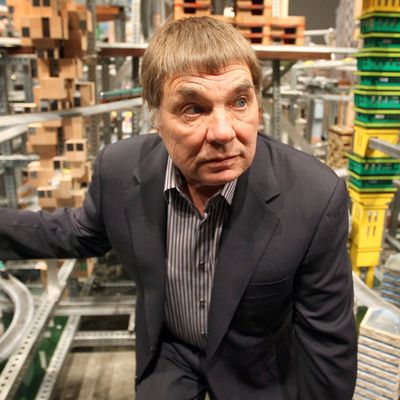
How great was artist Chris Burden? On November 19, 1971, out of nowhere, as if from some punk Plato’s cave of aesthetic contamination and perfection, Burden created a work of art so pure, perfect, self-evident, riveting, and revealing that it became an instant masterpiece of modern sculpture even though no one had ever seen it. At 7:45 p.m., in an alternative space in Santa Ana, California, he had himself shot in the left arm by a friend with a .22-long rifle from 15 feet away. The artist as a body that acts, is acted upon, and absorbs and changes material, becoming a meaning machine. A living sculpture come to dangerous life in the blink of an eye, sacrificing for his work while enacting a complex sadomasochism of love, hate, desire, and aggression. Shoot, as the work is known as, is America’s Duchamp’s urinal: a cipher and defining zero point of art. Lawrence Weiner once said that art isn’t just something that messes up your day, it should “fuck up their whole life.” That’s what Burden did to art from that day forward till he died yesterday, at 69.
Burden’s first piece, done while still a graduate student at the University of California, Irvine, was pure Kafka’s “Hunger Artist.” From April 26 until April 30, 1971, for his graduate thesis, Burden had himself locked in a two-foot-high, two-foot-wide, three-foot-deep locker. He stayed there without leaving for five days. The locker above him contained five gallons of water; the locker below him contained an empty five-gallon container. At the age of 25, Burden had distilled sculpture into a perfect system whereby the artist acted in public and private at the same time, functioning as a medium and passing point between states of being, transforming liquid within his body and excreting it in his own form. Another work of art so powerfully compact and dense in its implications, ideas, and intensity that it need not be seen. Only imagined.
In the 1970s, when Burden first took the stage, the art world was having one of its periodic nervous breakdowns. Painting was said to be dead; sculpture was starting over. Artists were dematerilaizing the art object, breaking it down, using their bodies as tools. Marina Abramovic worked as a prostitute during her show; Vito Acconci masturbated under a gallery floor; Joseph Beuys lived in a gallery with a live coyote; Jack Goldstein buried himself alive. Burden was part of this revolutionary aesthetic palace coup.
I loved Burden’s work. And was lucky enough to come into very early contact with it. Twice. On May 7, 1974, he performed Velvet Water in Chicago. For five minutes, a small group of us sat on metal folding chairs and watched a video monitor while in an adjacent room, Burden relentlessly dunked his head in a filled-up sink, trying to inhale the oxygen-rich water. We sat stupefied, paralyzed, until he seemed to pass out and the monitor went dark, and that was it. He’d tried to return to his amniotic amphibian state in real time. I knew art was a place where I wanted to be.
Back then, I worked as a guard at Chicago’s Museum of Contemporary Art. There, on April 11, 1974, Burden performed Doomed. He walked into the museum’s main gallery and laid down beneath a sheet of tilted glass. There was a clock nearby. Then he did nothing. He didn’t move, eat, drink, speak. The audience seated on the floor in front of him sat there. And did nothing. It was one of those 1970s moments where your ideas of time, boredom, creativity, credulity, faith, and passion were tested. I left when my shift was over; he was still there. The next afternoon, I heard he was still there. The day after that, I heard that he still hadn’t moved. This thing had gone from art to psycho. I knew something important was happening, not only to him but to me and to art. I rushed back to the museum. A handful of people were sitting there, transfixed, freaked out. Sun-Times film critic Roger Ebert later reported that a museum employee said, “It’s a really strange scene here right now.” Finally, 45 hours into this excruciating thing, fearing uremic poisoning or dehydration, my friend and fellow guard Dennis O’Shea placed a pitcher of water next to Burden. Just like that, Burden got up, got a hammer from another room, and broke the clock. The performance was over. So were lots of ideas about art. Burden told Ebert, “I thought, My God … are they going to leave me here to die?”
I could recount 20 more pieces of similar protean density and abstract essence. In the 1980s, Burden turned to making objects with the same immensity of emotion and mysterious cathartic power. A few years ago, in a great retrospective of his work at the New Museum, viewers could behold the ugly Big Wheel (1979). An eight-foot, 6,000-pound cast-iron flywheel mounted on a wooden pyramidlike structure. A real motorcycle is placed so that its rear wheel can make contact with the big iron one. A couple of times a day, a rider mounts the bike, shifts it so that the rear wheel makes contact with the flywheel, and revs the bike up to its top speed. Then the bike is turned off and pushed away. The iron wheel ominously spins for up to two hours. You are seeing oil chemically and mechanically converted into movement, flirting with perpetual motion, and on the edge of destruction — and nothing actually goes anywhere. Burden describes the piece as a “Neanderthal atomic bomb.”
It’s almost impossible to grasp the reach of Burden’s work, even if he always functioned as an outlaw, coming into the art world in bursts from out in the wilds. His importance to late-20th-century art cannot be overstated. Thank you, Chris, for fucking up my whole life.




